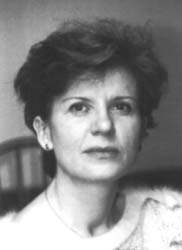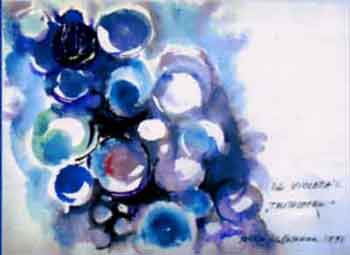Score
Works
VIOLETA DINESCU was born in 1953 in Bucharest. At college she attended a special
class for  mathematics
and physics. She studied composition, piano and pedagogy at the Ciprian Porumbescu
Conservatory in Bucharest, completing her education in 1976 with Honours. Recipient
of a 'George- Enescu Scholarship', she was also enabled to study composition
intensively with Myriam Marbe. In retrospect she regards this as the greatest
stroke of fortune in her life.
mathematics
and physics. She studied composition, piano and pedagogy at the Ciprian Porumbescu
Conservatory in Bucharest, completing her education in 1976 with Honours. Recipient
of a 'George- Enescu Scholarship', she was also enabled to study composition
intensively with Myriam Marbe. In retrospect she regards this as the greatest
stroke of fortune in her life.
Violeta Dinescu has lived in Germany since 1982. After teaching at the Academy
for Evangelical Church Music in Heidelberg (1986-1991), at the Academy for Performing
Arts in Frankfurt (1989-1992) and at the Professional Academy for Evangelical
Church music in Bayreuth (1990-1994) she became a full-time Professor of applied
composition at the Carl von Ossietzky University in Oldenburg in 1996 and frequently
directs courses in different parts of Europe and at several Universities in
the USA
Her list of works comprises innumerable compositions of various genres, amongst
them an opera for children 'The 35th of May' after Erich Kästner, the opera
'Hunger and Thirst' after Eugene Ionesco, 'Eréndira' after Gabriel Garcia
Mârquez and 'Schachnovelle' after Stefan Zweig. Her ballets include'Der
Kreisel' after Eduard Mörike and'Effi Briest' after Theodor Fontane as
well as music for the silent- film Tabu' by Friedrich Wilhelm Murnau and the
'Pfingstoratorium' (Pentecost Oratorio) based an texts from the bible. Also
of great importance is her chamber music for various instruments. Her compositions
have been awarded numerous international prizes and honours.
Works
|
Auswahl
ihrer Werke
|
| ICHTYS |
Violine, Violoncello und Klavier |
| ALTERNANZEN |
Bläserquintett |
| AUF DER SUCHE NACH MOZART |
Flöte, Fagott, Horn, Saxophon, Violine,Harfe, und Klavier/Celesta |
| TERRA LONHDANA |
Kammerensemble |
| MAP 67 |
Kammerensemble |
| VERWANDLUNGEN |
Orchester |
| ANNA PERENNA |
Orchester |
| MEMORIES |
Streichorchester |
| AKROSTICHON |
Orchester |
| MONDNÄCHTE |
Singstimme, Saxophon und Schlagzeug |
| DONA NOBIS PACEM |
Singstimme, Violoncello mit Schlagwerk |
| ZEBAOTH |
Bariton und zwei Orgeln |
| CONCERTINO |
Orchester mit Singstimme |
| BLIUMENLIED |
Chor a cappella |
| VERZAUBERE MICH IN EINEN SILBERVOGEL... |
Chor und Orchester |
HUNGER UND DURST |
Kammeroper nach Eugene Ionesco |
| DER 35. MAI |
Kinderoper nach Erich Kästner |
| ERÉNDIRA |
Kammeroper nach Gabriel Garcia Marquez |
| PFINGSTORATORIUM |
Solisten, zwei Chöre, Bläser, Blechbläserund Schlagzeug |
| SCHACHNOVELLE |
Komposition nach Stefan Zweig |
Violeta Dinescu - A Distinctive Personal Language
Monody
Undoubtedly, a fundamental device in Violeta Dinescu's music is the use of
monody. This is to be understood not only in the historical sense of the word,
that is a single-line chant or lament, but also as an expression of 'affect'
and an interpretation of emotions in the more 'human' sense of the word. Dinescu's
view of monody is deeply rooted in her Romanian homeland, and the use of declamatory
cantilena, either instrumental or vocal, gives rise to an unmistakably intense
musical idiom.
Moving almost imperceptibly from one instrument to another and combined with
alternating solo voices, the melodic line develops into an extended monologue
illuminated by contrasting colours. This form of monody is embellished through
the use of ornaments possibly inspired by North-Romanian 'Cântec Lung'
or Byzantine Chants. Similarly, the central tone of the melody is surrounded
by extended melismas and introduced by rapid figurations expanding like arabesque
motifs.
Such a procedure is closely linked to a 'parlando rubato' - a kind of free-flowing
texture - and the music of both'Doina' Romanian folk music and Byzantine chant.
It is the combination of 'parlando rubato' and the free use of melisma that
makes the music flow whilst creating a floating sense of time strongly contrasting
with the chronometrically organised texture. This is most apparent when improvised
monody, ornamentation and 'parlando rubato' techniques merge into extended solo
or unison passages. And, as in a suspended sense of space, the declamatory power
of the cantilena seems to be spanning from one point to another like in an imaginary
bridge.
Heterophony
The principle of Heterophony is most clearly demonstrated in compositions with
larger instrumentation. A central melody is modified, fractured, undergoes changes
of tone colour and appears in a new guise combined with chord- and cluster-formations.
Arising from an independently composed organic musical germ, the resulting elastic
fusions create the illusion of a certain procedure. In Dinescu's music, however,
the 'accident' is always controlled and leads to pre-selected channels. Even
passages where the notation requires the imagination of the performer or, through
the use of aleatoric notation presents a challenge to the Performer, are fully
integrated into the work. The fastidious and creative spirit of the composer
does not leave room for any kind of arbitrariness.
Violeta Dinescu's relationship with authentic folk music is not limited to adaptation
or imitation. Rather, the composer derives inspiration from basic principles
such as monody or techniques of embellishments. From these elements are distilled
characteristic elements and methods which form an 'essence of folkloré
and an 'essence of monody'. It is these 'essences' which form the foundation
of her point of departure, of her own concepts and compositional processes.
Superpositions
By means of the principle of heterophony the melodic line transforms itself
in one or more structural levels of the composition. Dinescu is fascinated by
the superpositions of these different levels. The musicjournalist Josef Häusler
referred to it as 'the geological aspect' of her music.
In her works one is reminded of the graphic representation of the earth's strata
with its horizontal courses, turnings and curvatures, offshoots, cuts and faults.
At the same time processes of monody homophony, polyphony and heterophony are
combined. They transform and superimpose themselves continuously with different
densities. Because this Vsible' construction is accompanied by the afore-mentioned
ornamental components, the inevitable result is a highly complex web of lines,
correlations and colours. Through the pulsating musical processes emerges a
characteristic compositional texture and Rhetoric, which could be described
as 'spatial musical thinking'. Foreground, middle-ground and background of the
composition are differently organised and 'translated' to various sonic levels,
each independent and yet closely related to each other.
Modi
By employing the above principle of heterophony Violeta Dinescu's music is based
neither an the tonal major/minor system nor an the twelve-tone system. The composer
works instead with 'modi'- that is, with a restricted selection of tones of
tones chosen to fit the demands of the new piece and put together in a certain
procedure. The'modi' form not only the melodic material but also produce in
vertical layers the characteristic Sound-scapes of this composer's music. For
the listener the impression is of 'controlled freedom'.
The construction of Dinescu's compositions has its roots in her studies of mathematics
and science. Mathematical processes influence formal considerations and control
the creation of music. Arithmetic and algorithmic elements are ingeniously combined.
Rational structures also determine the Organisation of the composition material.
Only rarely, if at all, can the attentive listener detect them in the resulting
sound complexes. In the music of Violeta Dinescu both scientific accuracy and
intuitive freedom are in constant interaction.
Just as important for her as the rigorous ordering of the material at the beginning
of the composition process is fantasy during rehearsal as a phase in preparation
for performance. She passes an to her musicians and to her listeners the longing
for freedom in a world whichworld, which is otherwise structured through objective
and rational rules. Within the boundaries set by the composer each player has
his own freedom of interpretation.
Zu diesem Gemälde von Gudrun Wassermann schrieb Violeta Dinescu das Stück
"Tautropfen" für Klarinette und Klavier

 mathematics
and physics. She studied composition, piano and pedagogy at the Ciprian Porumbescu
Conservatory in Bucharest, completing her education in 1976 with Honours. Recipient
of a 'George- Enescu Scholarship', she was also enabled to study composition
intensively with Myriam Marbe. In retrospect she regards this as the greatest
stroke of fortune in her life.
mathematics
and physics. She studied composition, piano and pedagogy at the Ciprian Porumbescu
Conservatory in Bucharest, completing her education in 1976 with Honours. Recipient
of a 'George- Enescu Scholarship', she was also enabled to study composition
intensively with Myriam Marbe. In retrospect she regards this as the greatest
stroke of fortune in her life.